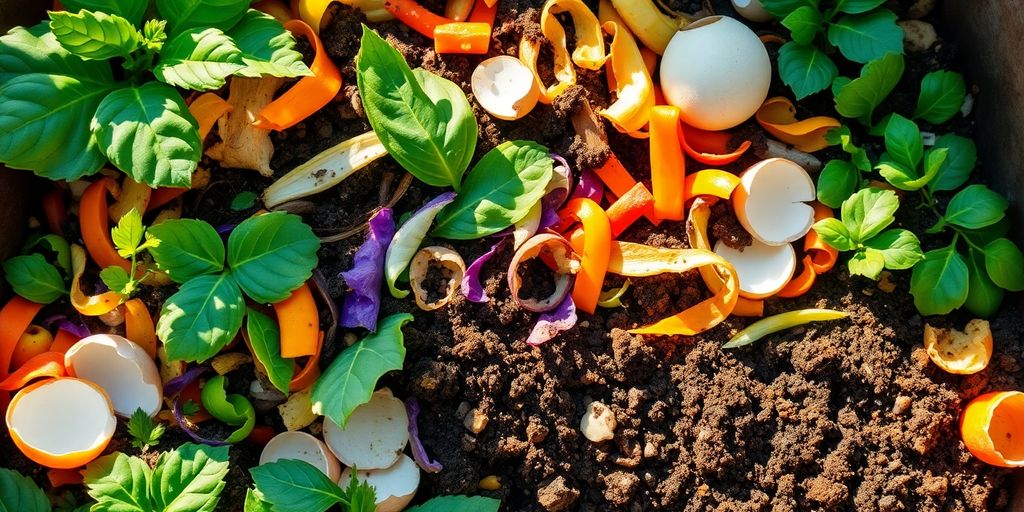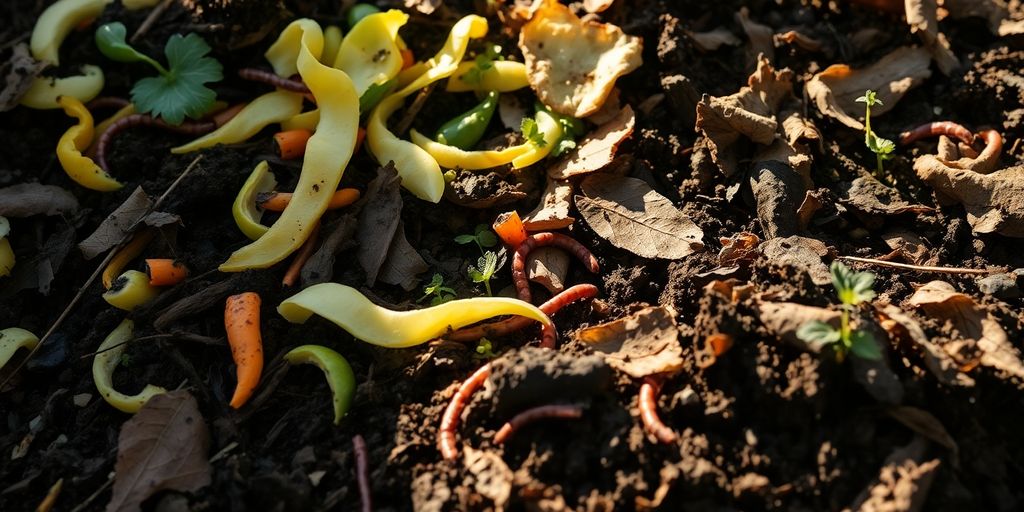Natural fertilizing: how to compost kitchen scraps for plants is a simple and sustainable way to boost your garden or houseplants. Instead of tossing leftovers, you can turn them into nutrient-rich soil. It’s eco-friendly and surprisingly easy to start.
Composting at home helps reduce waste while giving your plants exactly what they need to thrive. From fruit peels to coffee grounds, your kitchen is full of hidden plant food. All it takes is the right method and a bit of patience.
Even if you live in an apartment or have limited space, composting is still possible. With compact bins and odor-control tips, it can fit any lifestyle. You don’t need to be an expert to make it work.
Curious about how to begin? This guide will walk you through each step of composting with confidence and care. Let’s turn scraps into green, growing success.
Key takeaways
- Composting kitchen scraps helps improve soil quality and supports plant growth.
- Avoid adding meat, dairy, or oily foods to your compost pile to prevent odors and pests.
- Regularly turning and maintaining your compost will speed up the decomposition process.
Understanding the benefits of composting kitchen scraps
Okay, so you’re thinking about composting your kitchen scraps? Awesome! Let me tell you, it’s not just some crunchy-granola thing. It’s actually super practical and good for the planet. I started doing it a couple of years ago, and I’m not gonna lie, it felt a little weird at first, but now I’m totally hooked. Here’s why:
Enhancing soil health
Compost is like a super-vitamin for your soil. It’s packed with nutrients that plants love, and it helps the soil retain moisture, which is a big deal, especially if you live somewhere dry like I do.
Instead of buying expensive fertilizers, you’re basically making your own, for free! Plus, it improves the structure of the soil, making it easier for roots to grow. It’s a win-win.
Reducing kitchen waste
Seriously, think about how much food we throw away. It’s kinda crazy, right? Composting helps cut down on that waste big time. Instead of tossing those coffee grounds, veggie peels, and fruit cores into the trash, you’re giving them a new life. It feels good to know you’re not contributing as much to the landfill. Plus, less trash means fewer stinky garbage cans. I’m all about that!
Essential materials for successful composting

Alright, so you’re ready to dive into composting? Awesome! But before you start tossing everything into a pile, let’s talk about what you’ll actually need. Getting the right mix of materials is key to creating that black gold for your plants. I’ve learned this the hard way, believe me – a stinky, slow-to-decompose pile is no fun for anyone.
Kitchen scraps to include
Okay, so what can you toss in there? Think about it like this: if it grows, it goes (mostly!). Here’s a rundown of some of my go-to ingredients:
- Fruit and veggie scraps: This is the big one. Apple cores, banana peels, carrot tops, potato peelings – you name it. Just try to chop them up a bit first; it speeds things up.
- Coffee grounds and filters: My compost loves coffee! It adds nitrogen and helps with aeration. Plus, it’s a great way to recycle those used filters.
- Eggshells: Rinse ‘em out and crush ‘em up. They add calcium to the compost, which is great for your plants. I usually collect them in a bag until I have a decent amount.
Items to avoid in compost
Now, for the stuff you should never put in your compost. This is super important, because some things can attract pests, create nasty smells, or even harm your plants. Trust me, you don’t want any of that!
- Meat, dairy, and oily foods: These are a big no-no. They attract animals, create odors, and can take forever to break down. Plus, they can introduce harmful bacteria.
- Diseased plants: If a plant is sick, don’t compost it! You’ll just spread the disease to your other plants when you use the compost. Toss it in the trash instead.
- Pet waste: This is another one to avoid. It can contain harmful pathogens that you don’t want in your garden. Just stick to plant-based materials, and you’ll be golden.
Steps to create your compost pile

Layering your materials
Alright, let’s get down to the nitty-gritty of building your compost pile. I usually start with a base layer of twigs and coarser stuff. Think of it as creating some air channels – you want that pile to breathe! This also helps with drainage, which is super important.
Then, I alternate layers of “green” and “brown” materials. “Green” stuff is your kitchen scraps, grass clippings, coffee grounds – the nitrogen-rich goodies. “Brown” stuff is your leaves, cardboard, newspaper – the carbon-rich crew.
The key is to aim for about three parts brown to one part green. I chop things up a bit before tossing them in; smaller pieces break down faster. It’s not an exact science, so don’t sweat it too much. Just try to keep a good balance. I’ve found that layering like lasagna works wonders!
Maintaining your compost
Okay, so you’ve got your pile going. Now what? Well, it’s not a “set it and forget it” kind of deal. You gotta keep an eye on it. Moisture is key. You want it damp, like a wrung-out sponge. If it’s too dry, things slow down. If it’s too wet, it can get stinky.
I usually give it a sprinkle with the hose if it looks dry. Also, you need to turn it regularly. This gets air in there, which the microbes love. I try to turn mine once a week or so. When you turn it, you’ll notice the center is usually warmer – that’s a good sign! It means things are cooking.
If you want to get fancy, you can use a compost thermometer. But honestly, I just stick my hand in there (wear gloves, of course!). If it feels warm, you’re golden. If you keep up with this, you’ll have some beautiful compost in no time. It’s like magic, I tell ya!
Wrapping it up: Your composting journey
So, there you have it! Composting kitchen scraps is not just good for your plants; it’s a simple way to reduce waste and help the environment. You don’t need to be a gardening expert to get started. Just gather your scraps, mix them up, and let nature do its thing.
Remember, it might take a little time, but the payoff is worth it. Your garden will thrive, and you’ll feel great knowing you’re doing your part. So, why not give it a shot? You might just find it’s easier than you thought!
Frequently asked questions
What kind of kitchen scraps can I compost?
You can compost vegetable peels, fruit scraps, coffee grounds, and eggshells. Just make sure they are organic!
Are there any kitchen scraps I should avoid composting?
Yes, avoid composting meat, dairy, oils, and any processed foods. These can smell bad and attract pests.
How long does it take for compost to be ready?
It usually takes about 3 to 6 months for compost to break down, depending on how you manage it.
